Deck 8: Alkenes: Reactions and Synthesis
Question
Question
Question
Question
Question
Question
Question
Question
Question
Question
Question
Question
Question
Question
Question
Question
Question
Question
Question
Question
Question
Question
Question
Question
Question
Question
Question
Question
Question
Question
Question
Question
Question
Question
Question
Question
Question
Question
Question
Question
Question
Question

Unlock Deck
Sign up to unlock the cards in this deck!
Unlock Deck
Unlock Deck
1/42
Play
Full screen (f)
Deck 8: Alkenes: Reactions and Synthesis
1
Exhibit 8-3
Consider the reaction below to answer the following question(s).
Alkenes may be hydrated by the hydroboration/oxidation procedure shown.

Refer to Exhibit 8-3.Hydroboration/oxidation of alkenes occurs with:
A)anti stereochemistry.
B)trans stereochemistry.
C)syn stereochemistry.
D)unpredictable stereochemistry.
Consider the reaction below to answer the following question(s).
Alkenes may be hydrated by the hydroboration/oxidation procedure shown.

Refer to Exhibit 8-3.Hydroboration/oxidation of alkenes occurs with:
A)anti stereochemistry.
B)trans stereochemistry.
C)syn stereochemistry.
D)unpredictable stereochemistry.
syn stereochemistry.
2
Exhibit 8-5
The sequence of (1) alkene hydroxylation followed by (2) diol cleavage is often an excellent alternative to direct alkene cleavage with ozone.For this sequence below,answer the following question(s).

Refer to Exhibit 8-5.Give the formula for reagent B.
The sequence of (1) alkene hydroxylation followed by (2) diol cleavage is often an excellent alternative to direct alkene cleavage with ozone.For this sequence below,answer the following question(s).

Refer to Exhibit 8-5.Give the formula for reagent B.
HIO4
3
Exhibit 8-4
Consider the reaction below to answer the following question(s).
When dichlorocarbene is generated in the presence of an alkene,a dichlorocyclopropane is formed.

Refer to Exhibit 8-4.In the reaction of an alkene with dichlorocarbene,the dichlorocarbene is the:
A)electrophile.
B)Lewis base.
C)nucleophile.
D)both b and c
Consider the reaction below to answer the following question(s).
When dichlorocarbene is generated in the presence of an alkene,a dichlorocyclopropane is formed.

Refer to Exhibit 8-4.In the reaction of an alkene with dichlorocarbene,the dichlorocarbene is the:
A)electrophile.
B)Lewis base.
C)nucleophile.
D)both b and c
electrophile.
4
Exhibit 8-4
Consider the reaction below to answer the following question(s).
When dichlorocarbene is generated in the presence of an alkene,a dichlorocyclopropane is formed.

Refer to Exhibit 8-4.Write the complete stepwise mechanism for the formation of dichlorocarbene,CCl2.Show all intermediate structures and show all electron flow with arrows.
Consider the reaction below to answer the following question(s).
When dichlorocarbene is generated in the presence of an alkene,a dichlorocyclopropane is formed.

Refer to Exhibit 8-4.Write the complete stepwise mechanism for the formation of dichlorocarbene,CCl2.Show all intermediate structures and show all electron flow with arrows.

Unlock Deck
Unlock for access to all 42 flashcards in this deck.
Unlock Deck
k this deck
5
Exhibit 8-3
Consider the reaction below to answer the following question(s).
Alkenes may be hydrated by the hydroboration/oxidation procedure shown.

Refer to Exhibit 8-3.The regiochemistry of hydroboration/oxidation of alkenes is:
A)Markovnikov.
B)non-Markovnikov
C)subject to solvent effects.
D)unrelated to alkene structure.
Consider the reaction below to answer the following question(s).
Alkenes may be hydrated by the hydroboration/oxidation procedure shown.

Refer to Exhibit 8-3.The regiochemistry of hydroboration/oxidation of alkenes is:
A)Markovnikov.
B)non-Markovnikov
C)subject to solvent effects.
D)unrelated to alkene structure.

Unlock Deck
Unlock for access to all 42 flashcards in this deck.
Unlock Deck
k this deck
6
Exhibit 8-2
Consider the reaction sequence below to answer the following question(s):

Refer to Exhibit 8-2.The intermediate in the first step of this reaction sequence is called a:
A)carbocation
B)cyclonium ion
C)mercurinium ion
D)mercapto species.
Consider the reaction sequence below to answer the following question(s):

Refer to Exhibit 8-2.The intermediate in the first step of this reaction sequence is called a:
A)carbocation
B)cyclonium ion
C)mercurinium ion
D)mercapto species.

Unlock Deck
Unlock for access to all 42 flashcards in this deck.
Unlock Deck
k this deck
7
Exhibit 8-9
To answer the question(s) below consider the following information:
In an abandoned laboratory has been found a flammable liquid,A,in a bottle bearing only the label "Compound A: C7H12." Government agents have offered you a considerable sum to determine the structure of this compound.After verifying the molecular formula by elemental analysis,you find that Compound A reacts with 1 mol equiv of hydrogen;and,after treatment with acidic KMnO4,Compound A gives the dicarboxylic acid C (see below).Another bottle from the same laboratory is labeled "Compound B (isomer of A)." Compound B also reacts with 1 mol equiv of hydrogen,but yields cyclohexanone after treatment with acidic KMnO4.
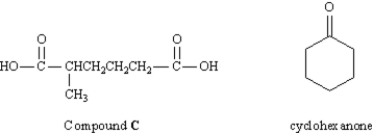
Refer to Exhibit 8-9.How many degrees of unsaturation does Compound A possess?
To answer the question(s) below consider the following information:
In an abandoned laboratory has been found a flammable liquid,A,in a bottle bearing only the label "Compound A: C7H12." Government agents have offered you a considerable sum to determine the structure of this compound.After verifying the molecular formula by elemental analysis,you find that Compound A reacts with 1 mol equiv of hydrogen;and,after treatment with acidic KMnO4,Compound A gives the dicarboxylic acid C (see below).Another bottle from the same laboratory is labeled "Compound B (isomer of A)." Compound B also reacts with 1 mol equiv of hydrogen,but yields cyclohexanone after treatment with acidic KMnO4.

Refer to Exhibit 8-9.How many degrees of unsaturation does Compound A possess?

Unlock Deck
Unlock for access to all 42 flashcards in this deck.
Unlock Deck
k this deck
8
Exhibit 8-4
Consider the reaction below to answer the following question(s).
When dichlorocarbene is generated in the presence of an alkene,a dichlorocyclopropane is formed.

Refer to Exhibit 8-4.The reaction of an alkene with dichlorocarbene is:
A)regiospecific.
B)Markovnikov.
C)stereospecific.
D)non-Markovnikov.
Consider the reaction below to answer the following question(s).
When dichlorocarbene is generated in the presence of an alkene,a dichlorocyclopropane is formed.

Refer to Exhibit 8-4.The reaction of an alkene with dichlorocarbene is:
A)regiospecific.
B)Markovnikov.
C)stereospecific.
D)non-Markovnikov.

Unlock Deck
Unlock for access to all 42 flashcards in this deck.
Unlock Deck
k this deck
9
Exhibit 8-2
Consider the reaction sequence below to answer the following question(s):

Refer to Exhibit 8-2.In the second step of this reaction sequence,the organomercury compound is treated with sodium borohydride,NaBH4,to yield the alcohol product.This replacement of a carbon-mercury bond with a carbon-hydrogen bond is termed:
A)an oxidation
B)a reduction
C)a hydroxylation
D)a cycloaddition
Consider the reaction sequence below to answer the following question(s):

Refer to Exhibit 8-2.In the second step of this reaction sequence,the organomercury compound is treated with sodium borohydride,NaBH4,to yield the alcohol product.This replacement of a carbon-mercury bond with a carbon-hydrogen bond is termed:
A)an oxidation
B)a reduction
C)a hydroxylation
D)a cycloaddition

Unlock Deck
Unlock for access to all 42 flashcards in this deck.
Unlock Deck
k this deck
10
Draw both chair conformations of trans-1,2-dichlorocyclohexane on the templates provided below.Circle the least stable conformation. 


Unlock Deck
Unlock for access to all 42 flashcards in this deck.
Unlock Deck
k this deck
11
Exhibit 8-3
Consider the reaction below to answer the following question(s).
Alkenes may be hydrated by the hydroboration/oxidation procedure shown.

Refer to Exhibit 8-3.Hydroboration of alkenes is an example of:
A)a rearrangement reaction.
B)a substitution reaction.
C)an elimination reaction.
D)an addition reaction.
Consider the reaction below to answer the following question(s).
Alkenes may be hydrated by the hydroboration/oxidation procedure shown.

Refer to Exhibit 8-3.Hydroboration of alkenes is an example of:
A)a rearrangement reaction.
B)a substitution reaction.
C)an elimination reaction.
D)an addition reaction.

Unlock Deck
Unlock for access to all 42 flashcards in this deck.
Unlock Deck
k this deck
12
Exhibit 8-1
To answer the question(s) below consider the following reaction:
When cyclohexene reacts with chlorine in carbon tetrachloride the trans-dihalide is formed.

Refer to Exhibit 8-1.Since the two chlorine atoms add to opposite faces of the cyclohexene double bond,we say that the reaction occurs with:
A)syn stereochemistry
B)cis stereochemistry
C)anti stereochemistry
D)retention of stereochemistry
To answer the question(s) below consider the following reaction:
When cyclohexene reacts with chlorine in carbon tetrachloride the trans-dihalide is formed.

Refer to Exhibit 8-1.Since the two chlorine atoms add to opposite faces of the cyclohexene double bond,we say that the reaction occurs with:
A)syn stereochemistry
B)cis stereochemistry
C)anti stereochemistry
D)retention of stereochemistry

Unlock Deck
Unlock for access to all 42 flashcards in this deck.
Unlock Deck
k this deck
13
Exhibit 8-2
Consider the reaction sequence below to answer the following question(s):

Refer to Exhibit 8-2.Write the complete reaction mechanism for the first step of this reaction sequence.Show all electron flow with arrows and show all intermediate structures.
Consider the reaction sequence below to answer the following question(s):

Refer to Exhibit 8-2.Write the complete reaction mechanism for the first step of this reaction sequence.Show all electron flow with arrows and show all intermediate structures.

Unlock Deck
Unlock for access to all 42 flashcards in this deck.
Unlock Deck
k this deck
14
Exhibit 8-3
Consider the reaction below to answer the following question(s).
Alkenes may be hydrated by the hydroboration/oxidation procedure shown.

Refer to Exhibit 8-3.The intermediate formed in the first step of this reaction is:
A)
B)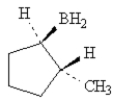
C)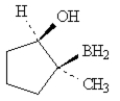
D)
Consider the reaction below to answer the following question(s).
Alkenes may be hydrated by the hydroboration/oxidation procedure shown.

Refer to Exhibit 8-3.The intermediate formed in the first step of this reaction is:
A)

B)

C)

D)


Unlock Deck
Unlock for access to all 42 flashcards in this deck.
Unlock Deck
k this deck
15
Exhibit 8-1
To answer the question(s) below consider the following reaction:
When cyclohexene reacts with chlorine in carbon tetrachloride the trans-dihalide is formed.

Refer to Exhibit 8-1.Write the complete stepwise mechanism for this reaction.Be sure to show all intermediate structures and all electron flow using arrows.
To answer the question(s) below consider the following reaction:
When cyclohexene reacts with chlorine in carbon tetrachloride the trans-dihalide is formed.

Refer to Exhibit 8-1.Write the complete stepwise mechanism for this reaction.Be sure to show all intermediate structures and all electron flow using arrows.

Unlock Deck
Unlock for access to all 42 flashcards in this deck.
Unlock Deck
k this deck
16
Exhibit 8-9
To answer the question(s) below consider the following information:
In an abandoned laboratory has been found a flammable liquid,A,in a bottle bearing only the label "Compound A: C7H12." Government agents have offered you a considerable sum to determine the structure of this compound.After verifying the molecular formula by elemental analysis,you find that Compound A reacts with 1 mol equiv of hydrogen;and,after treatment with acidic KMnO4,Compound A gives the dicarboxylic acid C (see below).Another bottle from the same laboratory is labeled "Compound B (isomer of A)." Compound B also reacts with 1 mol equiv of hydrogen,but yields cyclohexanone after treatment with acidic KMnO4.

Refer to Exhibit 8-9.Suggest structures for A and B.
To answer the question(s) below consider the following information:
In an abandoned laboratory has been found a flammable liquid,A,in a bottle bearing only the label "Compound A: C7H12." Government agents have offered you a considerable sum to determine the structure of this compound.After verifying the molecular formula by elemental analysis,you find that Compound A reacts with 1 mol equiv of hydrogen;and,after treatment with acidic KMnO4,Compound A gives the dicarboxylic acid C (see below).Another bottle from the same laboratory is labeled "Compound B (isomer of A)." Compound B also reacts with 1 mol equiv of hydrogen,but yields cyclohexanone after treatment with acidic KMnO4.

Refer to Exhibit 8-9.Suggest structures for A and B.

Unlock Deck
Unlock for access to all 42 flashcards in this deck.
Unlock Deck
k this deck
17
Exhibit 8-1
To answer the question(s) below consider the following reaction:
When cyclohexene reacts with chlorine in carbon tetrachloride the trans-dihalide is formed.

Refer to Exhibit 8-1.The observed stereochemistry of addition of chlorine to cyclohexene is explained by the intermediacy of a:
A)cyclonium ion
B)carbocation
C)carbene
D)chloronium ion
To answer the question(s) below consider the following reaction:
When cyclohexene reacts with chlorine in carbon tetrachloride the trans-dihalide is formed.

Refer to Exhibit 8-1.The observed stereochemistry of addition of chlorine to cyclohexene is explained by the intermediacy of a:
A)cyclonium ion
B)carbocation
C)carbene
D)chloronium ion

Unlock Deck
Unlock for access to all 42 flashcards in this deck.
Unlock Deck
k this deck
18
Exhibit 8-5
The sequence of (1) alkene hydroxylation followed by (2) diol cleavage is often an excellent alternative to direct alkene cleavage with ozone.For this sequence below,answer the following question(s).

Refer to Exhibit 8-5.Draw the structure of A.
The sequence of (1) alkene hydroxylation followed by (2) diol cleavage is often an excellent alternative to direct alkene cleavage with ozone.For this sequence below,answer the following question(s).

Refer to Exhibit 8-5.Draw the structure of A.

Unlock Deck
Unlock for access to all 42 flashcards in this deck.
Unlock Deck
k this deck
19
Exhibit 8-1
To answer the question(s) below consider the following reaction:
When cyclohexene reacts with chlorine in carbon tetrachloride the trans-dihalide is formed.

Provide the IUPAC name for the product of the reaction of cyclohexene with chlorine.
To answer the question(s) below consider the following reaction:
When cyclohexene reacts with chlorine in carbon tetrachloride the trans-dihalide is formed.

Provide the IUPAC name for the product of the reaction of cyclohexene with chlorine.

Unlock Deck
Unlock for access to all 42 flashcards in this deck.
Unlock Deck
k this deck
20
Exhibit 8-4
Consider the reaction below to answer the following question(s).
When dichlorocarbene is generated in the presence of an alkene,a dichlorocyclopropane is formed.

Refer to Exhibit 8-4.Draw the complete Lewis electron dot structure for dichlorocarbene,CCl2.
Consider the reaction below to answer the following question(s).
When dichlorocarbene is generated in the presence of an alkene,a dichlorocyclopropane is formed.

Refer to Exhibit 8-4.Draw the complete Lewis electron dot structure for dichlorocarbene,CCl2.

Unlock Deck
Unlock for access to all 42 flashcards in this deck.
Unlock Deck
k this deck
21
Draw the product(s) of the reaction of (R)-3-chlorobutene with HBr.Indicate stereochemistry.

Unlock Deck
Unlock for access to all 42 flashcards in this deck.
Unlock Deck
k this deck
22
Draw a condensed formula for a polymer containing five repeating units derived from the following monomer.Name the polymer. 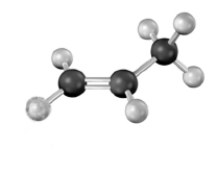


Unlock Deck
Unlock for access to all 42 flashcards in this deck.
Unlock Deck
k this deck
23
Which of the following is a difference between hydroboration/oxidation and oxymercuration?
A)conversion of an alkene to an alcohol
B)Markovnikov regiochemistry
C)hydration
D)heteroatom-containing intermediate
A)conversion of an alkene to an alcohol
B)Markovnikov regiochemistry
C)hydration
D)heteroatom-containing intermediate

Unlock Deck
Unlock for access to all 42 flashcards in this deck.
Unlock Deck
k this deck
24
Draw the skeletal structure(s) and name the product(s) of the reaction when the following substance is treated with ethanoic KOH.Atoms other than hydrogen and carbon are labeled. 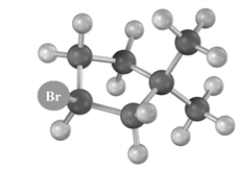


Unlock Deck
Unlock for access to all 42 flashcards in this deck.
Unlock Deck
k this deck
25
Consider partial hydrogenation of the following substance. 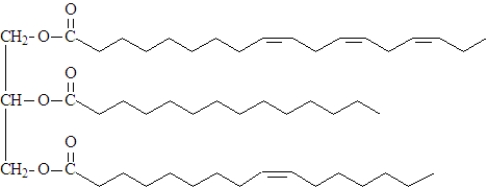 Which of the following describes this reaction?
Which of the following describes this reaction?
A)4 moles of hydrogen would required.
B)The product would contain trans double bond(s).
C)The product would be saturated.
D)The product would lower blood cholesterol.
E)All of the above would occur.
 Which of the following describes this reaction?
Which of the following describes this reaction?A)4 moles of hydrogen would required.
B)The product would contain trans double bond(s).
C)The product would be saturated.
D)The product would lower blood cholesterol.
E)All of the above would occur.

Unlock Deck
Unlock for access to all 42 flashcards in this deck.
Unlock Deck
k this deck
26
Consider the polymeric structure below for amylose (a type of starch).Draw a box around the monomer of amylose.Extra: Propose a structure for the monomer.Hint: This polymer is formed in a dehydration reaction. 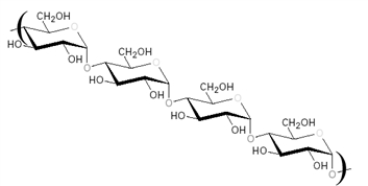


Unlock Deck
Unlock for access to all 42 flashcards in this deck.
Unlock Deck
k this deck
27
Consider the following polymer.  Draw the condensed formula for its monomer.
Draw the condensed formula for its monomer.
 Draw the condensed formula for its monomer.
Draw the condensed formula for its monomer.
Unlock Deck
Unlock for access to all 42 flashcards in this deck.
Unlock Deck
k this deck
28
Exhibit 8-9
To answer the question(s) below consider the following information:
In an abandoned laboratory has been found a flammable liquid,A,in a bottle bearing only the label "Compound A: C7H12." Government agents have offered you a considerable sum to determine the structure of this compound.After verifying the molecular formula by elemental analysis,you find that Compound A reacts with 1 mol equiv of hydrogen;and,after treatment with acidic KMnO4,Compound A gives the dicarboxylic acid C (see below).Another bottle from the same laboratory is labeled "Compound B (isomer of A)." Compound B also reacts with 1 mol equiv of hydrogen,but yields cyclohexanone after treatment with acidic KMnO4.

Refer to Exhibit 8-9.What was the other product formed in the KMnO4 oxidation of B?
To answer the question(s) below consider the following information:
In an abandoned laboratory has been found a flammable liquid,A,in a bottle bearing only the label "Compound A: C7H12." Government agents have offered you a considerable sum to determine the structure of this compound.After verifying the molecular formula by elemental analysis,you find that Compound A reacts with 1 mol equiv of hydrogen;and,after treatment with acidic KMnO4,Compound A gives the dicarboxylic acid C (see below).Another bottle from the same laboratory is labeled "Compound B (isomer of A)." Compound B also reacts with 1 mol equiv of hydrogen,but yields cyclohexanone after treatment with acidic KMnO4.

Refer to Exhibit 8-9.What was the other product formed in the KMnO4 oxidation of B?

Unlock Deck
Unlock for access to all 42 flashcards in this deck.
Unlock Deck
k this deck
29
Draw the mechanism of the bromination of 3-hexene in the presence of water via bromohydrin formation.

Unlock Deck
Unlock for access to all 42 flashcards in this deck.
Unlock Deck
k this deck
30
Consider the following intermediate. 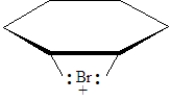 Which is applicable to this structure?
Which is applicable to this structure?
A)results in a product which has anti stereochemistry
B)produces only the cis isomer
C)is called a bromohydrin
D)occurs during the addition of HBr
 Which is applicable to this structure?
Which is applicable to this structure?A)results in a product which has anti stereochemistry
B)produces only the cis isomer
C)is called a bromohydrin
D)occurs during the addition of HBr

Unlock Deck
Unlock for access to all 42 flashcards in this deck.
Unlock Deck
k this deck
31
Draw the skeletal structure(s) and name the product(s) of the reaction when the following substance is treated with sulfuric acid and warmed to approximately 50 °C.Atoms other than hydrogen and carbon are labeled. 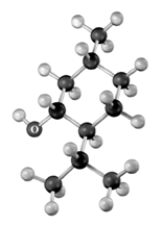


Unlock Deck
Unlock for access to all 42 flashcards in this deck.
Unlock Deck
k this deck
32
Which of the following will not undergo catalytic reduction in the presence of H2 and metal catalyst?
A)

B)

C)

D)

A)

B)

C)

D)


Unlock Deck
Unlock for access to all 42 flashcards in this deck.
Unlock Deck
k this deck
33
In the formation of an addition polymer such as polyvinylchloride,
A)the monomers must have at least one degree of unsaturation.
B)the formation occurs via a polar reaction.
C)the products have the same degree of complexity as biopolymers.
D)the resulting polymer generally contains two types of monomer.
A)the monomers must have at least one degree of unsaturation.
B)the formation occurs via a polar reaction.
C)the products have the same degree of complexity as biopolymers.
D)the resulting polymer generally contains two types of monomer.

Unlock Deck
Unlock for access to all 42 flashcards in this deck.
Unlock Deck
k this deck
34
Hydration of an alkene during enzyme catalysis in a biological system produces an optically active product even through there is a potential to form a racemic mixture.Explain why this occurs.

Unlock Deck
Unlock for access to all 42 flashcards in this deck.
Unlock Deck
k this deck
35
What product forms when the following substance is treated with chloroform in the presence of KOH? 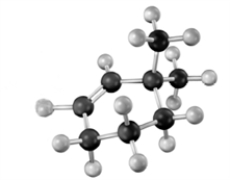
A)
B)
C)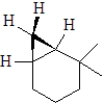
D)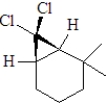

A)

B)

C)

D)


Unlock Deck
Unlock for access to all 42 flashcards in this deck.
Unlock Deck
k this deck
36
Povidone is produced commercially as a series of products having mean molecular weights ranging from about 10,000 to 700,000.Complexed with iodine,povidone yields an iodophor,marketed under the tradename Betadine,which is used as a topical anti-infective.  Identify the monomer unit(s) in povidone.
Identify the monomer unit(s) in povidone.
 Identify the monomer unit(s) in povidone.
Identify the monomer unit(s) in povidone.
Unlock Deck
Unlock for access to all 42 flashcards in this deck.
Unlock Deck
k this deck
37
Hydration of 4-methyl-1-pentene in the presence of an acid catalyst produces a product that is optically inactive.Briefly explain why.

Unlock Deck
Unlock for access to all 42 flashcards in this deck.
Unlock Deck
k this deck
38
Hydrogenation reactions use a metal catalyst as depicted below.  Which of the following does not occur during such a reaction?
Which of the following does not occur during such a reaction?
A)The metal provides a surface upon molecules can adsorb.
B)π bonds are involved in the interaction between the metal and the unsaturated hydrocarbon.
C)Molecular hydrogen attacks the topside of the adsorbed hydrocarbon.
D)Hydrogen atoms are transferred to the carbon atoms of the multiple bond one at a time.
 Which of the following does not occur during such a reaction?
Which of the following does not occur during such a reaction?A)The metal provides a surface upon molecules can adsorb.
B)π bonds are involved in the interaction between the metal and the unsaturated hydrocarbon.
C)Molecular hydrogen attacks the topside of the adsorbed hydrocarbon.
D)Hydrogen atoms are transferred to the carbon atoms of the multiple bond one at a time.

Unlock Deck
Unlock for access to all 42 flashcards in this deck.
Unlock Deck
k this deck
39
Which of the following is a carbene?
A)R3C+
B)R:-
C)R2:
D)R.
A)R3C+
B)R:-
C)R2:
D)R.

Unlock Deck
Unlock for access to all 42 flashcards in this deck.
Unlock Deck
k this deck
40
Lyapolate Sodium,whose structure is shown below,is used as an anticoagulant.Identify the monomer unit(s) in lyapolate sodium. 


Unlock Deck
Unlock for access to all 42 flashcards in this deck.
Unlock Deck
k this deck
41
Draw the mechanism of the epoxidation of 2-butene using a halohydrin.

Unlock Deck
Unlock for access to all 42 flashcards in this deck.
Unlock Deck
k this deck
42
Draw the mechanism of the hydration of 2-methyl-propene.

Unlock Deck
Unlock for access to all 42 flashcards in this deck.
Unlock Deck
k this deck



